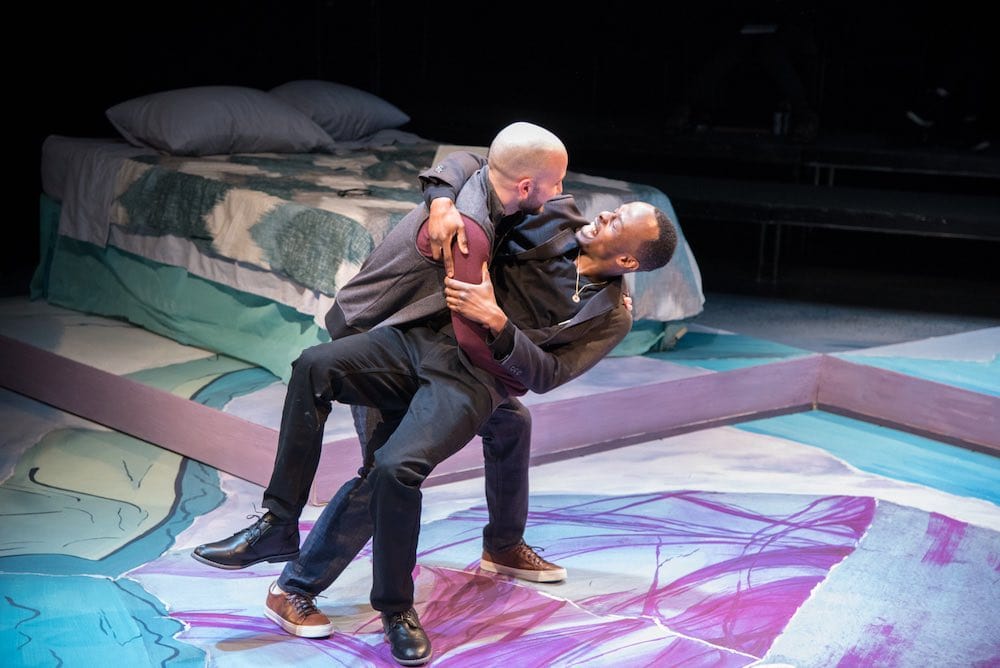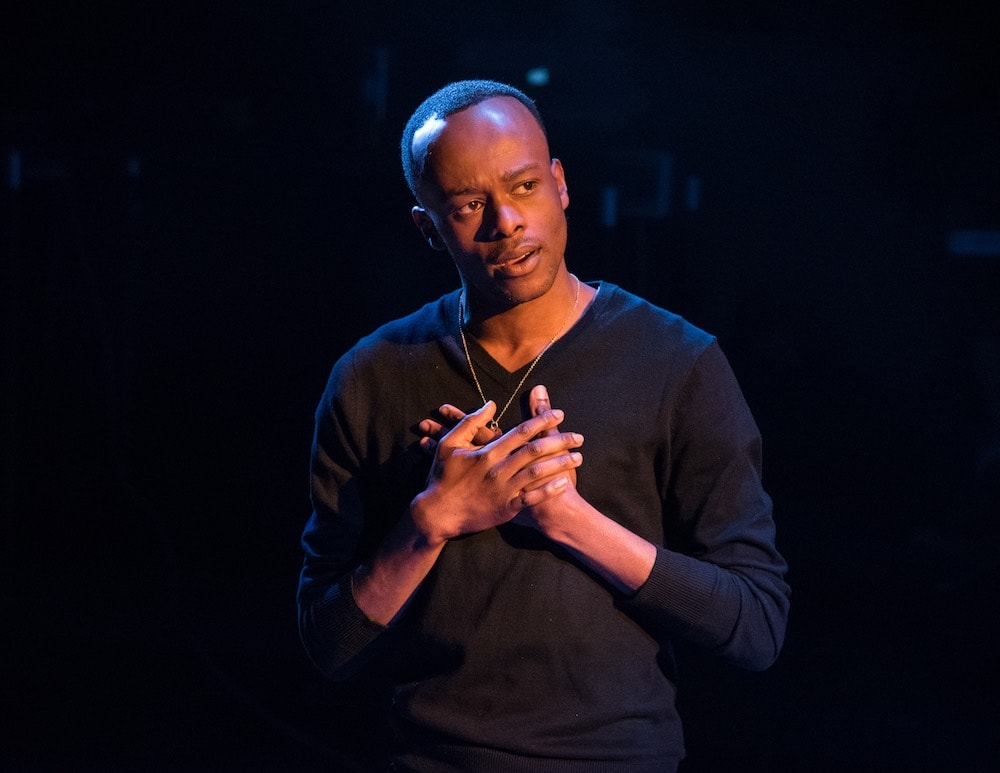A poetic and politically charged same-gender-loving love story, This Bitter Earth by Harrison David Rivers—now playing in a powerfully moving production at Theater Alliance—strips bare the hearts, hurts, and sexual heat of two men who face the hate outside across the color divide.

They meet by happenstance in 2012 at a Black Lives Matter protest following the fatal shooting of Trayvon Martin. Jesse (Justin Weaks), a young black aspiring playwright, is there reluctantly; his black roommate made him come. Neil (Noah Schaefer), a young white antiracist activist, is there in earnest, and he catches Jesse’s attention with an impromptu rally speech. Their subsequent high-tension connection is electric; their sexual attraction, intense. And as the play moves fluidly back and forth in time over the course of their two and a half years together—and as the story plays out against the persistent history of young black men shot dead—we are drawn ever more deeply into Jesse and Neil’s heartrending relationship: Their laughter and lovemaking. Their affinities and idiosyncrasies. Their arguments and cross-cultural disconnects.
Their contrasting backgrounds are disclosed in two separate meet-the-parents scenes. Justin’s mother and father are devout Baptists in denial about their son’s being out. Neil’s are wealthy liberals who welcome Jesse warmly.
But pivotally, a conflict arises early on between Jesse’s and Neil’s disparate responses to the antiblack violence in the world outside.
NEIL: …I find it hard to believe that you’re not bothered by what you see when you look around. When you watch the news or read the paper. When you leave yr apartment—
JESSE: It’s not that I don’t understand the importance of protest or whatever, the importance of speaking up and speaking out. I know my history. I’ve seen Eyes on the Prize—
Later, following the fatal shooting of Michael Brown, when Neil is preparing to go to Fergusson on a Freedom Ride—which Jesse declines to join and dismisses as a “’we are the world’ tour”—the conflict between them escalates:
NEIL: You know, you accuse me of my white guilt, but what about your apathy?
The privilege Neil brings into the relationship and the caution Jesse necessarily carries with him ignite what may be one of the most ruthlessly truthful interracial love stories the American stage has seen.

We sit on four sides of a multipurpose playing area (designed by Brian Gillick). Though it is set with a bed, bench, table and chairs, it’s more an unspecified memory space painted in magenta and aqua patterns (by Leila Spolter) as if huge petals from memorial flowers had fallen. While interlaced scenes play out here in intimate closeup, we will infer the where, when, and why from what Jesse and Neil say.
Overhead hang inauspicious clear shards. Between scenes flow the characters’ reminiscent music tracks and sounds (by Justin Schmitz) of breaking glass and drum-brushed cymbals. Dynamic changes of light (by John D. Alexander) heighten each dramatic location and emotional shift. Standing at opposite corners are two abstract doorways on which at times appear video projections (by Nitsan Scharf) of the actors’ eyes, lips, and hands. The visual effect while the actors are live onstage is stunning—the projections outsize and surreal, the performances painfully personal and in the moment.

Weaks as Jesse is magnetic from his opening monolog, where he first quotes Essex Hemphill, whose poetry will propel the play in profound ways. Weaks’s grace in motion and nuance of face and voice bring breathtaking shades of meaning and dimensions of feeling to the role. The dramaturgically assured directorial hand of Otis Ramsey-Zöe is especially evident in the clarity with which the performances illuminate how race inflects Jesse’s and Neil’s everyday life and in the fluency with which Rivers’s luminous language comes through.
Here, for instance, is a passage from a monologue in which Jesse explains with unabashed honesty why so many men he has been with have been white.
JESSIE: …maybe it’s that white men are allowed to be soft
That they’re encouraged by their mothers or their grandmothers or
whomever to be artistic
And self-aware
And maybe black men aren’t given that opportunity
(Not with the same frequency anyway)
Because maybe gentle gets you killed.
And maybe I’m attracted to that softness.
The physical interplay between Weaks and Schaefer’s characters is the sensual heartline of the play, its erotic epicenter, and is present throughout in Dane Figueroa Edidi’s exquisitely sensitive intimacy choreography. With Jesse and Neil’s every kiss, caress, and cuddle, we sense they have found with each other, for some brief and precious time, a trust and passion that might just might mitigate all that in the world would tear them apart. And when the action bursts out in actual choreography—as when Neil persuades Jesse to join him in the Twist, when Weaks breaks out in a gay bar “I Will Survive” number, and when Weaks stops the show dancing Jesse’s dream of a party with only black people—baby, the body electric gets sung.
Running Time: One hour 40 minutes, with no intermission.
This Bitter Earth plays through March 22, 2020, at Theater Alliance performing at Anacostia Playhouse – 2020 Shannon Place SE, in Washington, DC. Purchase tickets at the box office, or go online.
Credits
Director: Otis Ramsey-Zöe; Assistant Director: Vaughan Ryan Midder; Lighting Designer: John D. Alexander; Scenic Designer: Brian Gillick; Sound Designer: Justin Schmitz; Costume Designer: Brandee Mathies; Props Designer: Eric Swartz; Projections Designer: Nitsan Scharf; Intimacy Choreographer Dane Figueroa Edidi; Master Electrician: Elliott Shugoll; Scenic Artist: Leila Spolter; Assistant Scenic Artist: Megan Holden; Stage Manager: Thomas Nagata; Takeover Stage Manager: Ricky Ramón; Assistant Stage Manager: Genny Ceperley; Line Producer Aria Velz




